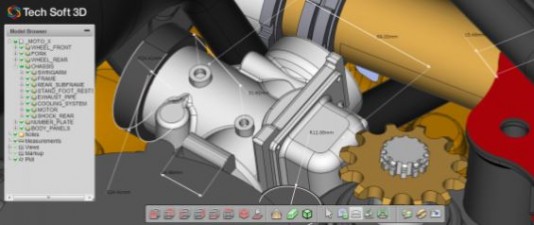The software developer with code on more desktops than Microsoft believes the Enterprise still wants Windows on mobile devices. Increased demand for 3D PDF is part of the shift.
Tech Soft 3D (TS3D), the small graphics software development house based in Bend, Oregon has only 450 customers—all of them other software companies. Because they supply complicated technology OEMs use to develop graphics products, TS3D gets a front-row view of what lies ahead in computing. So when Tech Soft 3D says Windows Mobile has a future, it is time to pay attention. After all, Tech Soft has code on more desktops than Microsoft, now that its 3D PDF technology is included in every copy of Adobe Acrobat Reader.

“Today the lines are blurring between desktop and mobile,” says Ron Fritz, TS3D co-founder and CEO. “Today [software development] is not about desktop OR mobile, but about desktop AND mobile.” When TS3D first offered its client-customers mobile technology for building graphics applications back in 2012, they focused on consumption as the main purpose, and iOS as the first technology. Today a shift has taken place; TS3D now believes enterprise users are willing to wait for the software they need to arrive on Windows Mobile, as opposed to accepting the consumer-oriented iOS and Android alternatives as a compromise.
Two trends are fueling the change. First, the major hardware vendors are finally coming to market with Windows-based tablets whose specs can compete in the marketplace. Second, the use case for tablets has shifted from consumption only to mixed use of tablets for both creation and consumption. As noted by Bill Barnes of Lattice 3D at TS3D’s annual customer conference last week at COFES, “Our clients are deploying Windows for core tasks, and iOS or Android for communications.”
If the trend in 2012 was “let’s go mobile,” what is the trend now? In a nutshell, here’s what Tech Soft 3D is preparing for:
Large is the New Medium: 3D technical graphics generate huge volumes of data, and when you strip them down for viewing only, much of the functionality technical professionals want is lost. As TS3D’s Gavin Bridgeman noted, not every technical graphics problem can be economically solved today by linking to a cloud, and CPU-based processing both locally and on the cloud is still a much cheaper proposition than using GPUs.
Sharing is Caring: 3D CAD never followed the path of 2D CAD and settled on one dominating file standard. Getting engineering data from one location to the other is not only a problem of operating systems and devices, it is also a problem of competing data formats. Tech Soft 3D is the official Adobe-certified OEM vendor of 3D PDF technology, and the company is seeing increased interest in 3D PDF as the way to share technical data without the typical headaches of interoperability and protecting intellectual property.
Using Models More, Talking About It Less: “Model-based design and model-based engineering is finally gaining traction in the enterprise,” says Fritz. “We are seeing real people doing real things with the technology.” The use of 3D models is becoming so commonplace, Fritz says, that the term will likely disappear as a way to distinguish engineering data.
Disruptive is the New Normal: Fritz says that when mobile was first moved from wish-list to must-do on the software development schedule, TS3D clients were looking for specific tools to solve specific problems. “But today we are having more conversations [with clients] about Blue Ocean marketing opportunities,” says Fritz. “This is the most disruptive and exciting time we’ve ever seen for 3D.”





